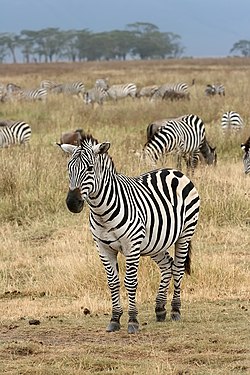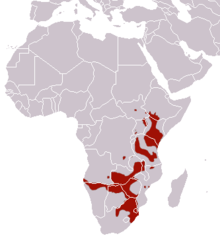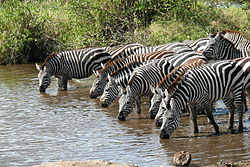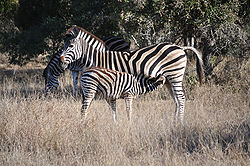Plains zebra
| Plains zebra | |
|---|---|

| |
| Equus quagga in the Ngorongoro Crater in Tanzania | |
| Scientific classification | |
| Kingdom: | |
| Phylum: | |
| Class: | |
| Order: | |
| Family: | |
| Genus: | |
| Subgenus: | |
| Species: | E. quagga
|
| Binomial name | |
| Equus quagga Boddaert, 1785
| |
| Subspecies | |
|
E. q. quagga † | |

| |
| Plains Zebra range | |
| Synonyms[1] | |
| |
The Plains zebra (Equus quagga, formerly Equus burchelli), also known as the Common zebra or Burchell's zebra, is the most common and geographically widespread form of zebra.[2] It ranges from the south of Ethiopia right through east Africa as far south as Angola and eastern South Africa. The plains zebra remains common in game reserves, but is threatened by human activities such as hunting it for its meat and hide, as well as encroachment on much of its former habitat.
Taxonomy
The Plains zebra and the mountain zebra belong to the subgenus Hippotigris, but Grévy's zebra is the sole species of subgenus Dolichohippus. The latter resembles an ass, while the former two are more horse-like. Nevertheless, DNA and molecular data show that zebras do indeed have monophyletic origins. All three belong to the genus Equus along with other living equids. In certain regions of Kenya, plains zebras and Grévy's zebras coexist. In captivity, Plains zebras have been crossed with mountain zebras. The hybrid foals lacked a dewlap and resembled the plains zebra apart from their larger ears and their hindquarters pattern.
Subspecies

In 2004, C.P. Groves and C.H. Bell investigated the taxonomy of the zebra genus, Equus, subgenus Hippotigris. They published their research in Mammalian Biology. They revised the subspecies of the plains zebra Equus quagga. Six subspecies are now recognizable. The completely maneless Somali population may represent a seventh subspecies: Equus quagga isabella (Ziccardi, 1958). This subspecies may be valid, but at present there is no evidence that it is.
- Quagga, †Equus quagga quagga – Boddaert, 1785
- Burchell's zebra, Equus quagga burchellii – Gray, 1824
- Grant's zebra, Equus quagga boehmi – Matschie, 1892
- Selous' Zebra, Equus quagga borensis – Lönnberg, 1921
- Chapman's zebra, Equus quagga chapmani – Layard, 1865
- Crawshay's Zebra, Equus quagga crawshayi – De Winton, 1896
The quagga was originally classified as an individual species, Equus quagga, in 1778. Over the next 50 years or so, many other zebras were described by naturalists and explorers. Because of the great variation in coat patterns (no two zebras are alike), taxonomists were left with a great number of described "species", and no easy way to tell which of these were true species, which were subspecies, and they were simply natural variants. The quagga was the first extinct creature to have its DNA studied. Recent genetic research at the Smithsonian Institution has demonstrated that the quagga was in fact not a separate species at all, but diverged from the plains zebra, between 120,000 and 290,000 years ago, and suggests that it should be named Equus burchelli quagga. However, according to the rules of biological nomenclature, where there are two or more alternative names for a single species, the name first used takes priority. As the quagga was described about thirty years earlier than the Burchell's zebra, it appears that the correct terms are E. quagga quagga for the quagga and E. quagga burchelli for the plains zebra, unless "Equus burchelli" is officially declared to be a nomen conservandum.
The Burchell's zebra was thought to have been hunted to extinction. However Groves and Bell concluded in their 2004 publication that "the extinct true Burchell's zebra" is a phantom. Careful study of the original zebra populations in Zululand and Swaziland, and of skins harvested on game farms in Zululand and Natal, has revealed that a certain small proportion shows similarity to what now is regarded as typical "burchellii". The type localities of the subspecies Equus quagga burchellii and Equus quagga antiquorum (Damara zebra) are so close to each other that the two are in fact one, and that therefore the older of the two names should take precedence over the younger. They therefore say that the correct name for the southernmost subspecies must be burchellii not antiquorum. The subspecies Equus quagga burchellii still exists in KwaZulu-Natal and in Etosha.
Physical description

The plains zebra is mid-sized and thick bodied with relatively short legs. Adults of both sexes stand about 1.4 meters (4.6 ft) high at the shoulder, are approximately 2.3 meters (8 ft) long, and weigh around 220–322 kg (484–708 lb). Males may weigh 10% more than females.
Like all zebras, they are boldly striped in black and white, and no two individuals look exactly alike. They also have black or dark muzzles. The natal coat of a foal is brown and white. All have vertical stripes on the forepart of the body, which tend towards the horizontal on the hindquarters. The northern populations have narrower and more defined striping;[3][4] southern populations have varied but lesser amounts of striping on the underparts, the legs and the hindquarters.[3] Southern populations also have brown "shadow" stripes between the black and white coloring.[3][4] These are absent or poorly expressed in northern zebras.[3][4]
An experiment was done at the Knoxville Zoo where a zebra was shaved. The underlying skin was black, not the previously thought white. The first subspecies to be described, the now-extinct quagga, had plain brown hindquarters. (Technically, because the quagga was described first as E. quagga, the proper zoological name for the most common form of the plains zebra is E. quagga burchelli.) There have been various mutations of the zebra's pelage from mostly white to mostly black.[5] Rare albino zebras have been recorded in the forests of Mount Kenya.[6]
Ecology
Range and habitat

The Plains zebra's range stops short of the Sahara from southern Sudan and southern Ethiopia extending south along eastern Africa, as far as Zambia, Mozambique, and Malawi, before spreading into most southern African countries. They are regionally extinct in Burundi and Lesotho, and they may have lived in Algeria in the Neolithic Era.[7]
Plains zebras generally live in treeless grasslands and savanna woodlands[4] but can be found in a variety of habitats, both tropical and temperate. However they are generally absent from deserts, dense rainforests and permanent wetlands.[4] Zebras also live in elevations from sea level to 4,300 m on Mount Kenya. They rely on rainfall for food and water, and thus have to go on great migrations to follow the rains. The zebras will migrate up to 700 miles (1,100 km) for food. Other grazers also must do the same thing. Plains zebras are highly water dependant[8] and are usually found within 25–30 kilometers of a water source.
Diet and predation
In one study, the zebra's diet was estimated to be 92% grass, 5% herbs, and 2% shrubs.[9] Unlike many of the large ungulates of Africa, the plains zebra does not require (but still prefers) short grass to graze. It eats a wide range of different grasses, preferring young, fresh growth where available, and also browses on leaves and shoots from time to time. In consequence, it ranges more widely than many other species, even into woodlands, and it is often the first grazing species to appear in a well-vegetated area.[8]
A zebras have a single stomach and use hind-gut fermentation which allows them to digest and assimilate larger amounts of forage during a 24-hour period.[10] Thus, zebra are less picky in foraging, but they do spend much time eating. The zebra is a pioneer grazer and prepares the way for more specialized grazers like blue wildebeests and Thomson's gazelles[8] who depend on short and more nutritional grasses.

The plains zebra's major predators are lions and spotted hyenas.[3] Nile crocodiles are also great threats during river crossings. Wild dogs, cheetahs, and leopards also prey on zebras, although the threats they pose are generally minor. Hyenas, dogs, cheetahs, and leopards mostly attack zebra foals.
Interactions with other grazers
Plains zebra herds will mix and migrate together along with other species such as wildebeests. Wildebeests and zebras generally coexist peacefully and will alert each other to predators. In one case, however, a gang of young zebra stallions isolated and harassed a wildebeest calf while keeping the mother at bay. The zebras chased and bit the young calf repeatedly. One zebra even trampled over it. The group eventually lost interest and the calf survived.[11] A similar incident happened when a lone wildebeest calf wandered too close to a gang of stallions and was kicked to death.[12]
Behavior
Social structure

The plains zebra is highly social and usually forms small family groups called harems, which consist of a single stallion, several mares, and their recent offspring. The adult membership of a harem is highly stable, typically remaining together for months to years. Bachelor males either live alone or with groups of other bachelors until they are ready to start their own harems. Multiple harems and bachelor groups come together to form herds, although these aggregations are highly fluid.
Stallions form harems by abducting young mares from their family harems.[8][13] When a mare reaches sexual maturity, she will exhibit the estrous posture, which attracts nearby stallions,[13] both bachelors and harem leaders. Her father will chase off or fight stallions attempting to abduct her. Even after a young mare is isolated from her natal harem, the fight over her continues until her estrous cycle is over, and it starts again with the next estrous cycle.[14] It is rare that the mare's original abductor keeps her for long.[14] When the mare finally ovulates, the male that impregnates her keeps her for good. Thus, the mare becomes a permanent member of a new harem.[14][15]
Mares exist in a hierarchy, with the alpha female being the first to mate with the stallion and being the one to lead the group. When new mares are added to the group, they are met with hostility by the other mares. Thus, the stallion must shield the new mares until the aggression subsides.[8][15] The most recently added females rank lowest. Females that become unfit or weak may drop in their rank, though. The female memberships of a harem stay intact even if a new stallion takes over. Zebras strengthen their social bonds with grooming. Members of a harem nip and scrape along the neck, shoulders, and back with their teeth and lips. Mothers and foals groom the most often, followed by siblings. Grooming shows social status and eases aggressive behavior.[8]

A stallion will defend his group from other males. When challenged, the stallion would issue a warning to the invader by rubbing nose or shoulder with him. If the warning is not heeded, a fight breaks out. Zebra fights often become very violent, with the animals biting at each other's necks, heads or legs, wrestling to the ground, and occasional kicking. Sometimes a stallion will lie still on the ground as if surrendering, but once the other male lets up, will strike and continue the fight.[8] Most fighting occurs over young mares in estrous, and as long as a harem stallion is healthy, he will usually not be challenged. Only unhealthy stallions have their harems taken over, and even then the new stallion gradually takes over pushing the old one out without a fight.[8] In fact, harem stallions have peaceful relations.[8] This is in contrast to mares who are hostile to mares from other harems.[8]
Communication
Zebras communicate with each other with high pitched barks and whinnying. A zebra's ears signify its mood. When a zebra is in a calm, tense or friendly mood, its ears stand erect. When it is frightened, its ears are pushed forward. When angry, the ears are pulled backward. When surveying an area for predators, zebras will stand in an alert posture, with ears erect, head held high, and staring. When tense, they will also snort. When a predator is spotted or sensed, a zebra will bark loudly.
Reproduction

The stallion mates with all his mares. Mares may give birth to one foal every twelve months. The birthing peak is during the rainy season. She nurses the foal for up to a year. The stallion is generally intolerant of foals that are not his. It is possible that zebras practice infanticide and feticide, although such incidences have only been observed in captive individuals.[16]
Like horses, zebras are able to stand, walk, and suckle shortly after they are born. At the moment of birth, a mother zebra keeps any other zebra away from her foal, including the stallion, the other mares, and even the previous offspring. Later, though, they all bond. Plains zebra foals are protected by their mother as well as the head stallion and the other mares in their group. Even with parental protection, up to 50% of zebra foals are taken by predation, disease, and starvation each year.
Young male zebras eventually leave their family groups. This is not because of sexual maturity or being kicked out by their fathers, but because their relationship with their mothers have faded after the birth of a sibling.[3][13] The young stallion then seeks out other young stallions for company.[13] Young females may stay in the harem until they are abducted by another stallion.[3]
Antipredatory behavior
For protection from land predators, the plains zebra retreats into open areas with good visibility at night. When the groups forage or sleep, one zebra will keep watch, and if a predator is spotted, it will bark or snort loudly.[3] When being hunted by hyenas or wild dogs, a zebra harem stays close together and cooperates to protect threatened members,[8] particularly the young. The harem stallion will go on the offensive and attack the dogs or hyenas.[8] Though hyenas may harass the stallion, they usually only concentrate on the herd, and attempt to dodge the stallion's assaults. Unlike stallions, mares typically only react aggressively to hyenas or dogs when their foals are threatened. Unlike wildebeest, zebras rarely take to water when escaping hyenas.[17] With lions, a zebra's best defense is to outpace them, as lions do not have as much endurance as hyenas or wild dogs. Cheetahs and leopards are mostly threats to foals as an adult zebra is fully capable of driving them away.
Human interactions
Conservation
Overall, the plains zebra population remains stable, and the species faces no major threat that would cause range-wide decline.[1] The zebra can be found in numerous protected areas across its range, including the Serengeti National Park in Tanzania, Tsavo and Masai Mara in Kenya, Hwange National Park in Zimbabwe, Etosha National Park in Namibia, and Kruger National Park in South Africa. There have even been stable populations in unprotected areas.[1]

Some local populations, though, have faced great declines and even extinctions. One subspecies, the quagga, is now extinct. In Tanzania, the zebra population has decreased by 20% from the late 1990s to the mid 2000s.[1] Zebras are threatened by hunting for their hide and meat, and habitat change from farming. They also compete with livestock for food. Poaching is largely a threat to northern populations, while southern populations are threatened mostly by habitat loss. Recent civil wars in Rwanda, Somalia, Sudan, Ethiopia, and Uganda have caused dramatic declines in all wildlife populations, including those of plains zebra. It is now extinct in Burundi. Civil war in Angola during much of the past 25 years has devastated its wildlife populations, including its once-abundant plains zebra, and destroyed the national parks administration and infrastructure.
Nevertheless, plains zebras are protected in most of their range. They are an important economic source in tourism.
In culture
The zebra is revered in some African cultures as a symbol of beauty. In the dances of the Karamojong tribe of Uganda, women would paint themselves in zebra stripes and act like them.[3] The Dube tribe of South Africa features a zebra on its totem. Zebras also appear on the coat of arms of Botswana.
References
Notes
- ^ a b c d e Template:IUCN2008 Database entry includes a brief justification of why this species is of least concern.
- ^ Grubb, P. (2005). "Order Perissodactyla". In Wilson, D.E.; Reeder, D.M (eds.). Mammal Species of the World: A Taxonomic and Geographic Reference (3rd ed.). Johns Hopkins University Press. p. 630. ISBN 978-0-8018-8221-0. OCLC 62265494.
- ^ a b c d e f g h i Kingdon 1979
- ^ a b c d e Moehlman 2002
- ^ http://www.messybeast.com/history/mutant-zebras.htm
- ^ http://www.animalorphanagekenya.org/members/bush_drums_2006_december.php
- ^ Groves C. P. (1974) Horses, Asses and Zebras in the Wild. Ralph Curtis Books, Hollywood
- ^ a b c d e f g h i j k l Estes 1991
- ^ Lamprey, H. F. (1963). Ecological separation of large mammal species in the Tangayika Game Reserve, Tangayika. E. Afr. Wildl. J. 63–93
- ^ Moehlman 2003
- ^ Wilderness Safaris - Zebra attack Blue Wildebeest foal
- ^ National Geographic Zebra: Patterns in the Grass (1991)
- ^ a b c d Moss 1982
- ^ a b c Klingel 1969
- ^ a b Adlen et al. 1995
- ^ Further evidence for male infanticide and feticide in captive plains zebras
- ^ Kruuk, Hans (1972). The Spotted Hyena: A study of predation and social behaviour. p. 335. ISBN 0563208449.
General references
- Alden, P. C., Estes, R.D., Schlitter, D., McBride, B. (1995). National Audubon Society Field Guide to African Wildlife. New York, Chanticleer Press, Inc. pg. 151
- Estes, R. (1991). The Behavior Guide to African Mammals, Including Hoofed Mammals, Carnivores, Primates. Los Angeles, University of California Press. pgs. 242–246
- Groves, C.P. and Bell, H.B. 2004. New investigations on the taxonomy of the zebras genus Equus, subgenus Hippotigris. Mammalian Biology. 69: 182–196.
- Template:IUCN2006
- Template:IUCN2006 (Extinct subspecies of the Plains Zebra.)
- Higuchi et al. (1987). Mitochondrial DNA of the Extinct Quagga: Relatedness and Extent of Postmortem Change. Journal of Molecular Evolution 25:283–287.
- Kingdon, J. (1979). East African Mammals: An Atlas of Evolution in Africa, Volume 3, Part B: Large Mammals. Chicago, University of Chicago Press. pgs. 165–179
- Klingel, H., (1969). Reproduction in the plains zebra Equus burchelli boehmi: behaviour and ecological factors. J. Reprod. Fertil., Suppl. 6: 339–345.
- Moelman, P.D. 2002. Equids. Zebras, Assess and Horses. Status Survey and Conservation Action Plan. IUCN/SSC Equid Specialist Group. IUCN, Gland, Switzerland. Chapter 4. Status and Action Plan for the Plains Zebra (Equus burchelli). Mace A. Hack, Rod East and Dan J Rubenstein. pgs. 43–57.
- Moehlman, P. D. (2003). Grizmek's Animal Life Encyclopedia. Mammals IV. Detroit, The Gale Group, Inc. 15.
- Moss, C., Ed. (1982). Portraits in the Wild, Animal Behavior in East Africa. Chicago, University of Chicago Press.
- IUCN Red List least concern species
- Mammals of Angola
- Mammals of Botswana
- Fauna of East Africa
- Mammals of Ethiopia
- Mammals of Namibia
- Mammals of South Africa
- Mammals of Sudan
- Mammals of Tanzania
- Mammals of the Democratic Republic of the Congo
- Fauna of the Sahara
- Mammals of Zambia
- Mammals of Africa
- Mammals of Kenya
- Zebras

